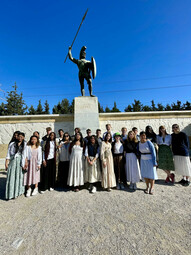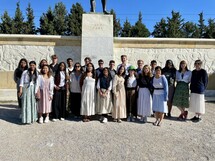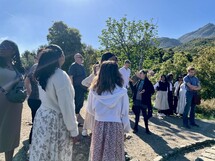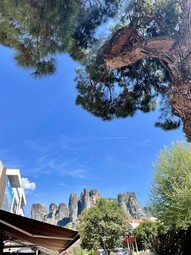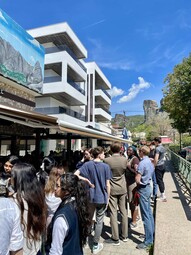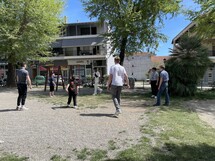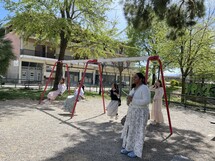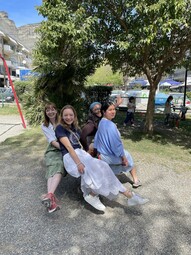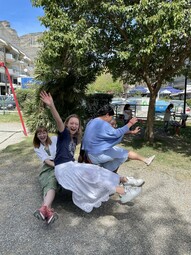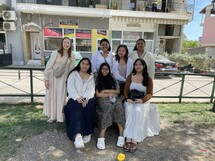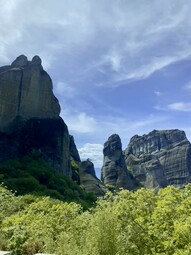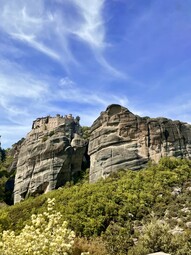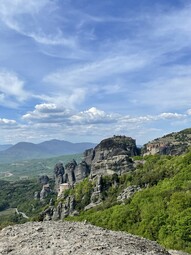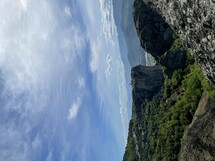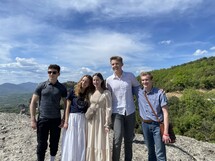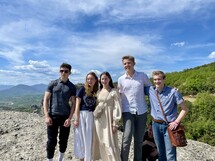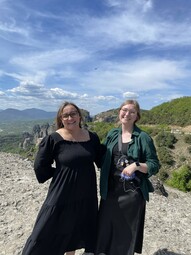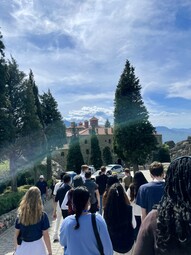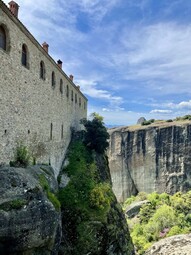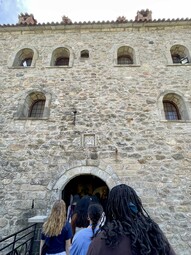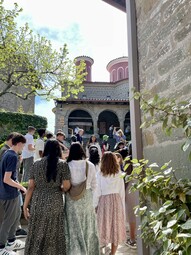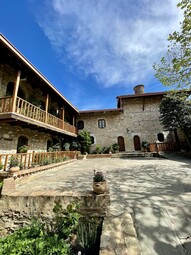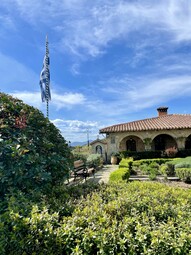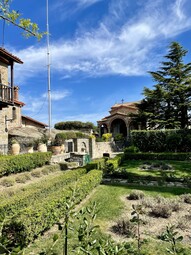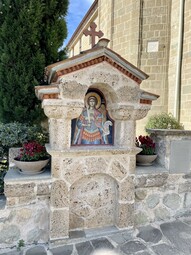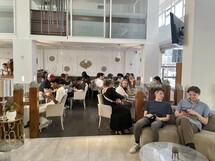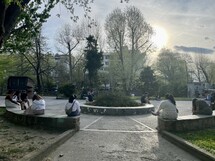Day 6: Thermopylae and Meteora
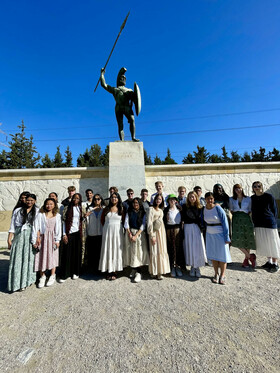
We have a four hour drive to Meteora, with a stop at Thermopylae on the way. We get off the bus in front of a towering statue of a Spartan holding a spear. The Battle of Thermopylae occurred in 480 BC between an alliance of Greek city states, led by King Leonidas I of Sparta, and the Persian Empire, led by King Xerxes I. Elie points out that the landscape has changed from what it would have been in the past; the sea would have come all the way up to where the highway currently is, leaving only a narrow strip of land between the mountains and the sea.
7,000 Greek forces were able to hold off 70,000 Persians for two days. However, despite their bravery and tactical advantage, the Greeks were eventually betrayed by a local resident who showed the Persians a hidden mountain path that allowed them to flank the Greek position.
Realizing their imminent defeat, Leonidas dismissed most of the Greek forces and retained only 300 Spartans and 700 Thespians to face down the entire Persian fleet. This was a calculated decision in order to allow the rest of Greece to retreat to the island of Salamis (the location of a significant future Greek victory against the Persians). Every soldier who stayed to fight did so by choice, knowing that they would be killed. The Spartan women in particular had a saying for their husbands: come back with your shield or on it. In other words, be victorious or die fighting. We walk up the hill to see a plaque that commemorates the fallen. It reads, “We died according to the laws of Sparta”.
This spirit of self-sacrifice demonstrated by these men serves as a powerful symbol of Greek resistance against Persian aggression. Remember, at this time these are separate city-states, but the Spartans and the Thespians who stayed behind sacrificed their lives to protect Greece.
We are reminded of not only how Jesus’ death is the ultimate expression of love and sacrifice, but also how he showed us how to live a life of sacrifice for the good of others. As Phillipians 2 says, “Do nothing out of selfish ambition or vain conceit. Rather, in humility value others above yourselves, not looking to your own interests but each of you to the interests of the others. In your relationships with one another, have the same mindset as Christ Jesus: Who, being in very nature God, did not consider equality with God something to be used to his own advantage; rather, he made himself nothing by taking the very nature of a servant, being made in human likeness. And being found in appearance as a man he humbled himself by becoming obedient to death— even death on a cross!”
Mr. Hartley also points out another interesting connection that points us back to Jesus. The Book of Esther in the bible records the story of King Xerxes marrying Esther for her beauty. Queen Esther becomes aware of a plot to annihilate the Jewish population and courageously goes before the king, risking her life, to plead for the protection and preservation of her people. She finds favor with Xerxes and her people are saved. This story foreshadows Jesus as our mediator and deliverer.
Next, we drive some more before stopping for an extended lunch. A monastery towers above us on a spire of rock in the distance. This will be our next stop! The patio sits just in front of a playground area. Owen, Luke, Sammy, Keagan, Arie, and Joel begin playing soccer with two boys, while many other students go to the swings and the playground. We find out later that one of the boys is the grandson of the owner of the restaurant and at one point, his mother came out to watch her son play with these older Canadians. It was a wholesome moment and we commended our students when we reboard the bus. Mrs. Kooiker says: “This is an ‘aha’ moment for us as your leaders. You are being salt and light. It's not in the grand gestures, although it can be those things too. It's in the small, mundane moments.”
The bus is filled with energy as we make our way up, up, up to the top of the massive spires of rock that rise into the air. Tina, our guide for Meteora, has joined us on the bus and provides information as we drive up. Students lean over to one side of the bus where the monasteries sit atop the spires, some of them now below us. Tina points out a hole in one of the towering rocks that is filled with colorful flags. Once a year, people rock climb to this location to leave an offering. We stop at a scenic lookout, an outcropping of rock, to take pictures.
The monks who initially came to this area and built the six monasteries in 1798 were seeking solitude, isolation, and a high place to pray. All six monasteries are active today; four of them are for monks and two of them are for nuns. St. Stephen’s monastery, our destination, was bombed during WWII by the Nazis. While the roof collapsed, the wooden walls inside the church itself, with their intricate floral carved designs, survived. These carvings date back 200 years and were done by the monks. In 1961, this monastery was repurposed for nuns and it became a convent. The requirements to join are that you must be Orthodox, over 18 years old, and after a trial period of a few months, make a vow to remain forever. The daily schedule of these women is to pray for 8 hours a day (3.5h in the morning, 3.5 hours in the evening, and 1 hour at night), work for 8 hours, and rest for 8 hours.
Students look around the church in awe, as every surface is painted with scenes from the bible and from church history. 32 years ago, a 25 year old came to the monastery and offered to complete the paintings for them. The same man has been working on it ever since and it is still not complete. These scenes in the paintings are based on the tradition of the Orthodox church and the bible. At the top of the dome is a painting of Jesus, who they call “The Almighty”, because he is the protector.
After settling into our hotel, we find a courtyard for the students to separate and have some individual devotional time before coming together to discuss our experiences at Meteora. Kyla shares about how even though we may come from different traditions, we can find inspiration in the nuns' devotion to God. Mr. Hartley leads a conversation about the formation of and differences between the Orthodox, Roman Catholic, and Protestant churches. Our school is non-denominational and has students from all traditions. Ultimately, we know that the heart of our Christian faith is found in the person of Jesus, our savior and Lord, and that we are all invited to follow him.
We eat dinner together, Italian tonight, out on a patio before heading back to the hotel for bed.

